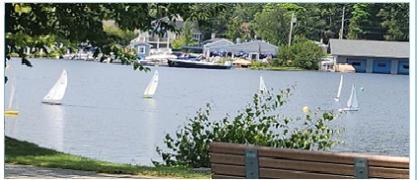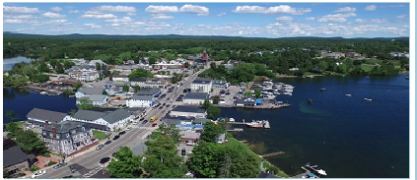Lake Wentworth and Crescent Lake Water Quality Summary
Lake Wentworth and Crescent Lake are discussed together, as they are not only hydrologically linked, but they have often been studied together, and they are both a focus of the Wentworth Watershed Association .
A comprehensive watershed assessment and management was prepared for Lake Wentworth and Crescent Lake in 2012. (appendices)
This plan summarized all the data going back to 1975 in Lake Wentworth and 1984 in Crescent Lake, identified noteworthy issues concerning the water quality of the two lakes, and has served asthe guide for ongoing mitigation actions to preserve and enhance the lakes. The Wentworth Watershed Association has taken the lead in continuing to assess the conditions and trends in water quality of the two lakes and in organizing the numerous actions that have been taken and are being taken to protect and improve the water quality of the two lakes. They have hosted the annual Water Summit Conference in Wolfeboro since 2017. Summit #4 is May4, 2020 at the Wolfeboro Town Hall. For more information go to the Wentworth Watershed Association website.
The 2012 assessment identified Lake Wentworth as impaired due to
- low pH (less than the minimum standard of 6.5),
- low dissolved oxygen, and
- the presence of exotic milfoil (variable milfoil) in the bays near Heath, Hersey, and Willey Brooks.
- It also set a goal of reducing total phosphorous levels in the surface waters 15 % by 2030 from 6.7 ug/L to 5.7 ug/L.
The 2012 assessment identified Crescent Lake as impaired due to
- extensive milfoil.
- It also set a goal of reducing total phosphorous levels in the surface waters 15 % by 2030 from 7.9 ug/L to 6.7 ug/L.
Our lakes naturally have little buffering capacity (e.g., limestone). Therefore, they are vulnerable to acid rain coming from outside our local area and state. So, there are limited local options to address Lake Wentworth’s low pH. Fortunately, its average pH was only slightly below 6.5. Also, fortunately, environmental regulations and switches away from coal-fired power plants have reduced the amounts of acidic sulfur dioxide in the air, which when transported cause local acid rain.
There has been an extensive effort by the Town of Wolfeboro and the Wentworth Watershed Association to address the milfoil in the two lakes and Back/Front Bay in Lake Winnipesaukee. The efforts have been keeping the invasive plant levels down. While some believe that total elimination will be impossible, the Lake Sunapee Association claims that an infestation in their lake has been completely eradicated.
The watershed assessment found that Lake Wentworth waters stratify in place over summers, but Crescent Lake does not. Three monitoring sites have been used to track dissolved oxygen profiles inthe lake: Site 2 Triggs, 1 Fullers, and Governor’s Deep. {See Appendix C} Over late Summer 2009,the dissolved oxygen level at
- Site 2 Triggs went down to a little below 5 ug/L, fair/mesotrophic (UNH classification) at about 49 feet deep (15 meters),
- 1 Fullers went down to a little below 1 ug/L, poor/eutrophic at about 79 feet deep (24 meters), and
- Governor’s Deep was completely depleted, poor/eutrophic, by 56 feet (17m) deep in lateAugust and by 46 feet (14m) deep in early September.
As such oxygen depletion is caused by bacteria consuming organic material already on the bottom of the lake, late summer oxygen levels near the bottom of Lake Wentworth are not likely to improve until a significant portion of such organic matter has been consumed. The most important actions that can be taken to help this along is to reduce further inputs of organic matter to the lake, which are being pursued.
The most recent data for Lake Wentworth over Summer 2018,t he dissolved oxygen level at
- Site 2 Triggs was not measured,
- 1 Fullers went down to 4.2 ug/L, fair/mesotrophic at about 79 feet deep (24 meters), and
- Governor’s Deep went down to 4.2 ug/L, fair/mesotrophic, by 56 feet (17m) deep in lateAugust and by 46 feet (14m) deep in early September.
Such dissolved oxygen profiles can vary from year to year, so it takes several years to determine trends. However, if these more recent results are representative of the future, dissolved oxygen levels in Lake Wentworth may be improving.
The 2012 assessment recognized that for Crescent Lake to achieve its goal to reduce total phosphorous levels will require reductions in the levels of Lake Wentworth that feed into it. The most recently available complete data for total phosphorous levels in the two lakes are from 2018. They indicate:
- a 2018 Crescent Lake average total phosphorous concentration of 7.5 ug/L, a slight reduction from the 2012 level of 7.9 ug/L
- a 2018 Lake Wentworth average total phosphorous concentration of 5.3 ug/L, which if sustained in the future, would represent achievement of the goal of a 15% reduction called for in the watershed assessment. Here, here, and here
Again, total phosphorous concentration measurements, like many water quality parameters have a lot of noise or variability. So, it takes several years to determine trends. However, Lake Wentworth having an average total phosphorous level of 5.3 ug/L in 2018, a reduction of 1.4 ug/L compared to 2009 is preferable to having an average in 2018 that was considerably higher than 2009.










